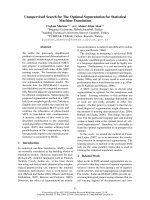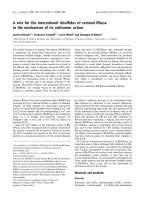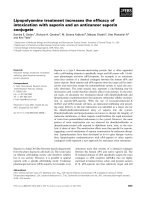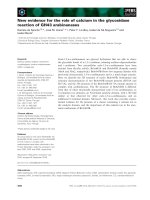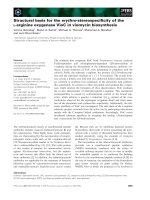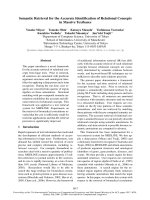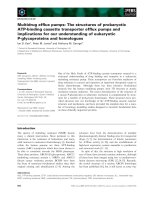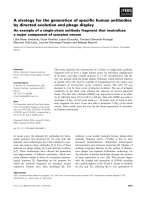Báo cáo khoa học: "Medical treatment for the terminally ill: the ‘risk of unacceptable badness’"
Bạn đang xem bản rút gọn của tài liệu. Xem và tải ngay bản đầy đủ của tài liệu tại đây (33.51 KB, 2 trang )
317
ICU = intensive care unit.
Available online />Abstract
When patients or their families rarely request inappropriate end of
life care in the ICU for capricious reasons. End of life treatment
decisions that only prolong discomfort and death are usually
emotional and based on unrealistic expectations. I explore some of
those reasons in this paper.
Recent times have witnessed much turmoil regarding the ‘life
is sacred at any cost’ maxim [1]. Current technology is
capable of indiscriminately maintaining some of the vital
functions of the body, but the same technology does not
necessarily allow us to heal underlying disease processes [2].
An unintended side effect of modern technological advances
has been the plausibility of maintaining moribund patients in a
state of suspended animation for prolonged and sometimes
indefinite periods [3]. Also, advanced resuscitation
techniques make it possible to convert death into life-in-death
[4]. Patients may be stalled in suspended animation; they are
not alive in the sense the we enjoy life but neither are they
able to die as long as nutrition, hydration, ventilation, and
perfusion are assured. In many cases reanimation of such
patients is clearly impossible, even with the advanced
medical technologies available to us.
This conundrum is created because we must be prepared to
apply life-sustaining technology to patients when the benefit
appears to outweigh the risk and when there is a reasonable
chance for an outcome that the patient would desire. It
frequently seems reasonable to buy sufficient time to see
whether the disease will respond to aggressive treatment by
instituting the most invasive life support technology. However,
if organ system failure is not reversible, then the reasoning
behind life support technology becomes moot. We must then
be prepared to remove supportive technology when it
appears that inevitable death is being delayed, rather than
meaningful life prolonged [5].
The courts have repeatedly affirmed competent a patient’s
authority to regulate their medical treatment, regardless of
their reasoning [6]. However, when the patient becomes
incapacitated, family surrogates are granted authority to make
decisions regarding treatment options because of their
proximate knowledge of what the patient would have wanted
before they became incompetent [7]. This position is based
on the postulate that any attempt to interject physician
paternalism into the surrogate decision-making equation is
ethically unacceptable. Most rational surrogates are unwilling
to continue life support after a reasonable trial has
demonstrated that its benefit has passed the point of
diminishing returns. However, there is a continuing trend of
surrogates demanding that moribund patients be kept on life
support after prevailing medical opinions concur that there is
no meaningful chance of reanimation [8].
Some reasons why this occurs are as follows:
1. Physicians tell surrogates that they can make any decision
they want as an open-ended ideal. This puts them in the
position of being buyers in a consumer’s market. By
asking them to make a choice, they imply that their
authority to make choices extends to making bad ones.
2. Moribund patients look comfortable on ‘life support’. An
observer’s primal reaction to the vibrant external appearance
of a body supported in an intensive care unit (ICU) is
radically different from that to a corpse on a morgue slab [9].
As long as the patient ‘looks viable, it is emotionally easier to
accept the pie in the sky bye and bye long shot cure’. If the
patient can just be maintained comfortably for long enough,
then a cure may eventually become possible.
3. Surrogates dislike being in a position of making decisions
that directly result in the death of a loved one. Once life-
supporting care is instituted, the patient has options for
‘survival’ that they did not have before, even though they
are dependent on ‘life support’. There are now variables
Commentary
Medical treatment for the terminally ill: the ‘risk of unacceptable
badness’
David Crippen
Associate Professor, Director, Neurovascular ICU, Department of Critical Care Medicine, University of Pittsburgh Medical Center, Pittsburgh,
Pennsylvania, USA
Corresponding author: David Crippen,
Published online: 10 May 2005 Critical Care 2005, 9:317-318 (DOI 10.1186/cc3715)
This article is online at />© 2005 BioMed Central Ltd
318
Critical Care August 2005 Vol 9 No 4 Crippen
that decision makers control, and it is much easier to
avoid decisions that may hasten death [10]. Instead of
yielding to inevitable death, the potential now exists to
manipulate it. Life support generates an outcome that is
no longer inevitably fatal.
4. Physicians do not have an exceptional track record in
explaining end-of-life issues to patients and their families
[11]. It is not uncommon for physicians to ask loaded
questions in their quest for end-of-life decisions. For
example, ‘This is your grandmother’s 17th transfer from a
skilled nursing facility in 3 months for sepsis and
respiratory failure, and now she’s in kidney failure as well.
What do you want to do: everything or let her die?’ Given
that choice, most surrogates would opt for doing
something rather than nothing, even if ‘something’
perpetuated open-ended pain and discomfort.
5. The popular media, especially the tabloids, frequently
feature anecdotal articles describing patients who have
awakened after years of coma [12]. Most if not all of these
patients’ conditions have been embellished to generate
public interest, and frequently subsequent investigators
cannot find these patients. Accordingly, some families feel
that if life support systems can maintain vital signs for a
day or a week, then ‘suspended animation’ should be
possible indefinitely, until a cure is found.
6. The notion of ‘medical futility’ as an end-stage process in
which vital signs cannot be supported further is poorly
understood by both physicians and surrogates [13]. In
fact, any medical treatment capable of sustaining
hemodynamics, ventilation, and metabolism is not
technically futile if it achieves that limited goal [14]. A
treatment is futile only if it is unsuccessful in achieving a
stated goal. Therefore, if a patient in a progressive,
inevitable death spiral is placed on mechanical ventilation,
it is not technically futile if vital signs are sustained,
however briefly. It is medically inappropriate but not
technically futile. Under the current rules, the only test of
futility is that embodied by the question, ‘Will this
treatment result in sustained life?’ If the answer is ‘yes’,
then virtually any treatment is fair game, even if it will do
nothing to revitalize the patient.
Perhaps the most effective way of dealing with strong familial
incentives to tread the path of least resistance in end-of-life
care is twofold. First, in end-of-life issue discussions, we must
strive for ‘consensus without consent’ [15]. Discussions with
surrogates should strive for concordance and understanding
but not extend to soliciting their consent for medically
inappropriate care. They simply should not be offered
inappropriate end-of-life care. Second, we should strive to
emphasize what Streat and coworkers [15] termed, ‘the large
risk of unacceptable badness’, rather than a vanishingly small
potential for benefit.
There are far worse things than death, and many of them occur
in ICUs when futility maxims are circumvented. There is a
population of ICU patients who will die no matter what
treatment is rendered them. Medically inappropriate care
causes pain, suffering, and discomfort. The fundamental maxim
for these patients should be comfort. Extraordinary life support
for patients predicted to die does not equal comfort care.
Competing interests
The author(s) declare that they have no competing interests.
References
1. Silverman HJ: Withdrawal of feeding-tubes from incompetent
patients: the Terri Schiavo case raises new issues regarding
who decides in end-of-life decision making. Intensive Care
Med 2005, 31:480-481.
2. Afessa B, Keegan MT, Mohammad Z, Finkielman JD, Peters SG:
Identifying potentially ineffective care in the sickest critically
ill patients on the third ICU day. Chest 2004, 126:1905-1909.
3. Powner DJ, Bernstein IM: Extended somatic support for preg-
nant women after brain death. Crit Care Med 2003, 31:1241-
1249.
4. Khalafi K, Ravakhah K, West BC: Avoiding the futility of resusci-
tation. Resuscitation 2001, 50:161-166.
5. Crippen D: Terminally weaning awake patients from life sus-
taining mechanical ventilation:the critical care physician’s role
in comfortmeasures during the dying process. Clin Intensive
Care 1992, 3:206-212.
6. Luce JM, Alpers A: End-of-life care: what do the American
courts say? Crit Care Med 2001, Suppl:N40-N45.
7. Arnold RM, Kellum J: Justifications for surrogate decision
making in the intensive care unit: implications and limitations.
Crit Care Med 2003, Suppl:S347-S353.
8. Goold SD, Williams B, Arnold RM: Conflicts regarding deci-
sions to limit treatment: a differential diagnosis. JAMA 2000,
283:909-914.
9. Whetstine L: When is ‘dead’ dead: an examination of the
medical and philosophical literature on the determination of
death. Dissertation. Pittsburgh, PA: Duquesne University; 2004.
10. Crippen D, Levy M, Whetstine L, Kuce J: Debate: What consti-
tutes ‘terminality’and how does itrelate to a living will? Crit
Care 2000, 4:333-338.
11. Lynn J, Teno JM, Phillips RS, Wu AW, Desbiens N, Harrold J,
Claessens MT, Wenger N, Kreling B, Connors AF Jr: Perceptions
by family members of the dying experience of older and seri-
ously ill patients. SUPPORT Investigators. Study to Under-
stand Prognoses and Preferences for Outcomes and Risks of
Treatments. Ann Intern Med 1997, 126:97-106.
12. Man awakes after 19 years in coma. [ />stories/2003/07/09/health/main562293.shtml] (Last accessed
28 April 2005).
13. Frick S, Uehlinger DE, Zuercher Zenklusen RM: Medical futility:
predicting outcome of intensive care unit patients by nurses
and doctors – a prospective comparative study. Crit Care Med
2003, 31:456-461.
14. Kelly D: Medical futility in American health care. In Three
Patients: End of Life Care in Intensive Care Medicine. Edited by
Crippen D, Kilkullen J, Kelly D. New York: Kluwer Publishers;
2002:7-23.
15. Cassell J, Buchman TG, Streat S, Stewart RM, Buchman TG:
Surgeons, intensivists, and the covenant of care: administra-
tive models and values affecting care at the end of life. Crit
Care Med 2003, 31:1263-1270.

